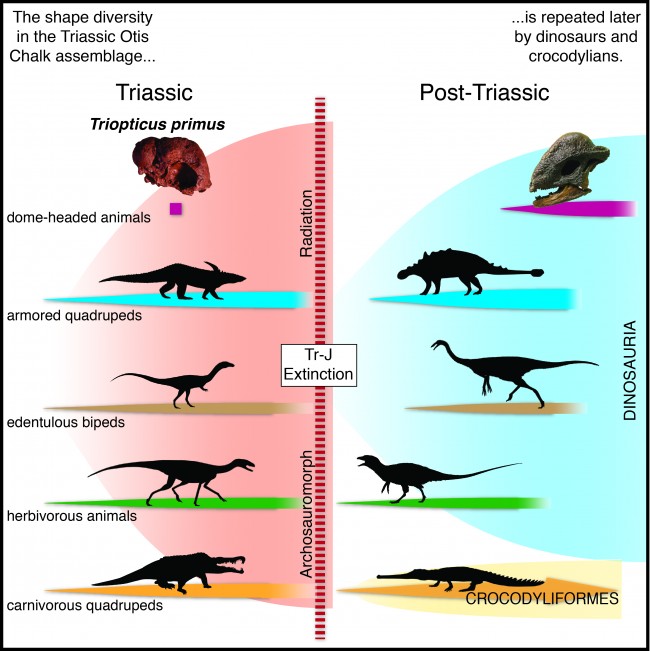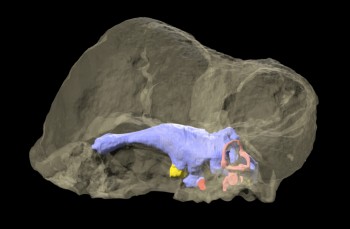New Species of Ancient Texas Reptile Offers Clues to Evolution of Dinosaurs
September 22, 2016

A newly described species of extinct reptile that roamed Texas more than 200 million years ago had a strikingly dome-shaped head with a very thick skull and a large natural pit on top that lends the appearance of an extra eye, according to a study released Sept. 22 in Current Biology.
The study, led by researchers at Virginia Tech, looked at a 230-million-year-old skull in the collection at The University of Texas at Austin’s Jackson School of Geosciences. The skull of the new species Triopticus primus, meaning “the first with three eyes,” was also scanned at the Jackson School’s CT lab to reconstruct the internal anatomy, which would not be visible without cutting the bones into pieces.
The findings reveal new clues about the evolutionary history of dinosaurs because the thickened skull roof is nearly identical to that of the distantly related pachycephalosaur dinosaurs that lived more than 100 million years later. Many of the other extinct animals found with Triopticus also resemble later dinosaurs.
“Triopticus is an extraordinary example of evolutionary convergence between the relatives of dinosaurs and crocodylians and later dinosaurs that is much more common than anyone ever expected,” said lead author and Virginia Tech research scientist Michelle Stocker. “What we thought were unique body shapes in many dinosaurs actually evolved millions of years before in the Triassic Period.”
Convergence — where distantly related animals evolve to look similar to one another — is a widely recognized phenomenon in evolutionary biology. A classic example of this is a bird wing and a bat wing — both animals use their wings for flight, but the inner details of those wings are different and evolved independently.
Many of the other Triassic reptiles buried with Triopticus display structures that are also easily recognized later in dinosaurs, such as the long snouts of Spinosaurus, the toothless beaks of ornithomimids, and the armor plates of ankylosaurs. Researchers said it is extremely rare to have so many diverse species in a single ancient community be converged upon over a broad swath of later geologic time.
Dinosaurs, like these distant cousins from the Triassic Period, are all reptiles. Reptiles rapidly evolved in terms of numbers of species soon after the greatest mass extinction of all time, at the end of the Permian Period.
“After the enormous mass extinction 250 million years ago, reptiles exploded onto the scene and almost immediately diversified into many different sizes and shapes. These early body shapes were later mimicked by dinosaurs,” said Sterling Nesbitt, an assistant professor of paleontology at Virginia Tech and co-author of the study.
Complete details of what Triopticus primus looked like and how big it was are not yet known, though it was probably no bigger than an alligator. For now, researchers only have a fragment of skull. The remainder is missing, either long lost to natural elements, waiting to be found out in the field still, or inside a plaster jacket not yet opened at the lab at UT Austin.
Though many fossils are uncovered during long stints of dusty fieldwork in far-off places, the team’s discovery of this specimen — originally collected near Big Spring, Texas, by the Work Projects Administration (WPA) in 1940 — happened in the Jackson School’s Texas Vertebrate Paleontology Collections in 2010, where it had been lying in plain sight for 70 years. Stocker was a Ph.D. student and Nesbitt was a postdoctoral researcher, both at the Jackson School, when they found the specimen.

It is not uncommon for new species to be found in fossil collections around the world. The WPA, a Depression-era work program, found so many fossils during its short span of work that they didn’t have time to clean all of them.
“We can gain new insights into the history of life because specimens like Triopticus have been curated into museum collections like the one at UT Austin,” said Matthew Brown, co-author and director of the Texas Vertebrate Paleontology Collections. “These collections are the foundation of natural history research, and this new animal illustrates how exciting discoveries are continually made thanks to the forethought and investment of past generations. It will be fascinating to see what the students of tomorrow find next.”
Jackson School Professor Timothy Rowe was a co-author, as were former Jackson School students Katharine Criswell, now a Ph.D. student at the University of Chicago, and William Parker, now a paleontologist at Petrified Forest National Park. Scientists with Ohio University also contributed.
More information, including interactive 3D renderings of the specimen, can be found atwww.jsg.utexas.edu/vpl/triopticus/.
For more information contact: Anton Caputo, UT Jackson School of Geosciences communications director, 512-232-9623; or Monica Kortsha, UT Jackson School of Geosciences public affairs officer, 512-471-2241.
